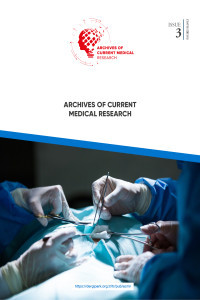Elderly burns; Our clinical experiences
Elderly burns; Our clinical experiences
Burns, Aged, Mortality, Comorbidity,
___
- 1. TurkStat. İstatistiklerle Yaşlılar. 2020. https://data.tuik.gov.tr/Bulten/Index?p=Istatistiklerle-Yaslilar-2020-37227. Accessed. September 20, 2021
- 2. Wang W, Zhang J, Lv Y, Zhang P, Huang Y, Xiang F. Epidemiological Investigation of Elderly Patients with Severe Burns at a Major Burn Center in Southwest China. Med Sci Monit. 2020;26:e918537.
- 3. Mahar P, Wasiak J, Bailey M, Cleland H. Clinical factors affecting mortality in elderly burn patients admitted to a burns service. Burns. 2008;34(5):629-36.
- 4. McGill V, Kowal-Vern A, Gamelli RL. Outcome for older burn patients. Arch Surg. 2000;135(3):320-5.
- 5. Huang SB, Chang WH, Huang CH, Tsai CH. Management of Elderly Burn Patients, Int J Gerontol. 2008; 2(3):91-97.
- 6. Jacobson RG, Flowers FP. Skin changes with aging and disease. Wound Repair Regen. 1996;4(3):311-5. doi: 10.1046/j.1524-475X.1996.40305.x. PMID: 17177725.
- 7. Jeschke MG, Patsouris D, Stanojcic M, Abdullahi A, Rehou S, Pinto R, et al. Pathophysiologic Response to Burns in the Elderly. EBioMedicine. 2015;2(10):1536-48.
- 8. Pham TN, Kramer CB, Wang J, Rivara FP, Heimbach DM, Gibran NS, et al. Epidemiology and outcomes of older adults with burn injury: an analysis of the National Burn Repository. J Burn Care Res. 2009;30(1):30-6.
- 9. Mabrouk A, Maher A, Nasser S. An epidemiologic study of elderly burn patients in Ain Shams University Burn Unit, Cairo, Egypt. Burns. 2003;29(7):687-90.
- 10. Lewandowski R, Pegg S, Fortier K, Skimmings A. Burn injuries in the elderly. Burns. 1993;19(6):513-5.
- 11. Vendrusculo TM, Balieiro CR, Echevarría-Guanilo ME, Farina Junior JA, Rossi LA. Burns in the domestic environment: characteristics and circumstances of accidents. Rev Lat Am Enfermagem. 2010;18(3):444- 51.
- 12. Hunt JL, Arnoldo BD, Purdue GF. Prevention Of Burn Injuries. In: Herndon DN, editor. Total Burn Care. Elsevier Health Sciences; 2012. p. 47-55.
- 13. Keck M, Lumenta DB, Andel H, Kamolz LP, Frey M. Burn treatment in the elderly. Burns. 2009 ;35(8):1071-9.
- 14. Sayampanathan AA. Systematic review of complications and outcomes of diabetic patients with burn trauma. Burns. 2016;42(8):1644-1651.
- 15. Satman I, Yilmaz T, Sengül A, Salman S, Salman F, Uygur S, et al. Population-based study of diabetes and risk characteristics in Turkey: results of the turkish diabetes epidemiology study (TURDEP). Diabetes Care. 2002;25(9):1551-6.
- 16. Satman I, Omer B, Tutuncu Y, Kalaca S, Gedik S, Dinccag N, et al. TURDEP-II Study Group. Twelve-year trends in the prevalence and risk factors of diabetes and prediabetes in Turkish adults. Eur J Epidemiol. 2013;28(2):169-80.
- 17. Faurie MP, Allorto NL, Aldous C, Clarke DL. A closer look at burn injuries and epilepsy in a developing world burn service. S Afr J Surg. 2015;53(3 and 4):48-50.
- 18. Osler T, Glance LG, Hosmer DW. Simplified estimates of the probability of death after burn injuries: extending and updating the baux score. J Trauma. 2010;68(3):690-7.
- 19. Wibbenmeyer LA, Amelon MJ, Morgan LJ, Robinson BK, Chang PX, Lewis R 2nd, et al. Predicting survival in an elderly burn patient population. Burns. 2001;27(6):583-90.
- 20. Farinas AF, Bamba R, Pollins AC, Cardwell NL, Nanney LB, Thayer WP. Burn wounds in the young versus the aged patient display differential immunological responses. Burns. 2018;44(6):1475-1481.
- 21. Larson CM, Saffle JR, Sullivan J. Lifestyle adjustments in elderly patients after burn injury. J Burn Care Rehabil. 1992;13(1):48-52.
- Yayın Aralığı: Yılda 3 Sayı
- Başlangıç: 2020
- Yayıncı: 14 Mart Tıbbiyeliler Derneği
Oruç YUNUSOĞLU, Çagla KÖSE, Andleeb SHAHZADİ, Bülent DEMİR, Burak ÖNAL, Sibel ÖZYAZGAN, Ahmet Gökhan AKKAN
Percutaneous radiofrequency nerve ablation in patients with chronic heel pain
Aydın YAVUZ, Hüseyin GÖBÜT, Çağrı BÜYÜKKASAP, Kürşat DİKMEN, Hasan BOSTANCI, Ahmet YALÇINKAYA, Mehmet CİNGİRT, Özlem GÜLBAHAR, Tuğba TAŞKIN TÜRKMENOĞLU, Aydın DALGIÇ
Barış HEKİMOĞLU, Muhammet Ali BEYOGLU
From a dermatologist point of view, enthesopathy and peripheral neuropathy in psoriasis patients
Sevgi KULAKLI, Nilgün ATAKAN, Gökhan ÇAĞLAYAN, Ayşen AKINCI, Levent ÖZÇAKAR
Clinical and microbiological characteristics of Candida meningitis/ventriculitis in children
Ümmühan ÇAY, Nisa Nur TAPAÇ, Adnan BARUTÇU, Derya ALABAZ, Özlem ÖZGÜR GÜNDEŞLİOĞLU, Filiz KİBAR, Kadir OKTAY
Risk of morbidity and mortality in preterm infants born to advanced maternal age pregnancies
Burak CERAN, Ufuk ÇAKIR, Duran YILDIZ, Ali Ulaş TUĞCU, Selcan SINACI, Cüneyt TAYMAN
Ayça BİLGİNOĞLU, Makbule Fulya TUTAR SELÇUK
Heavy hemolysis after organophosphate poisoning by chlorpyrifos ethyl
